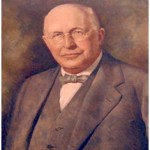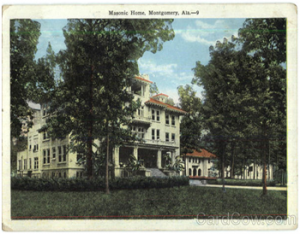A BRIEF HISTORY OF HILLWOOD
In 1836, in his formative years, young Luther Leonidas Hill moved with his parents from North Carolina to Greensboro, AL. Years later, he would marry Mary Walton of Augusta, GA who would later inherit a huge parcel of farmland in Montgomery County on which sits the portion of present day Hillwood from Croom Dr. eastward to Perry

Hill Rd. In 1856, shortly before the outbreak of the Civil War, The Reverend Luther Leonidas Hill, by then a Methodist minister, paid a visit to inspect his wife’s Montgomery County property. Upon his return to Greensboro, he was stunned to find his wife and all but one of their seven children dead of Scarlet Fever. Five years later, in 1861, on the dawn of the Civil war, The Reverend Hill would remarry Laura Sarah Croom who would bear eight more of his children, the oldest of which, Dr. Luther Leonidas Hill, Jr. would become the first American physician to perform a successful open-heart surgery.
Near the end of the Civil War and because of the threat of being overrun by Wilson’s Raiders of the Union Calvary, Reverend Hill, Sr. buried his family silver in the area where Silver Lane sits today, hence the name Silver Lane. He buried the silver alone since he trusted no one with his secret.
Upon the death of The Reverend Luther Leonidas Hill, Sr., his children each inherited parcels that collectively make up the eastern half of Hillwood including the present day Aronov development of Windsor Hill and the Montgomery Academy Lower School campus.
Almost a century later, in 1956, during the throes of the Montgomery bus boycott, the city was just beginning its eastward push that would later gather momentum. In those days, the Montgomery city limits sign was in the vicinity of the current-day intersection of Wentworth and Vaughn Rd. The Hill property, far from being the urbanesque Midtown that we know today, was out in the county. That year, 1956, Vaughn Hill Robinson sold a section, heavily wooded with pines and oaks, of his mother’s property and under the direction of Aronov Realty and former Montgomery Mayor (1946-1951) and Alabama Supreme Court Justice John Lancaster (Wank) Goodwyn, the first phase of the new Hillwood development commenced. That original Hillwood development consisted only of the first blocks of Croom Dr., Hillwood Dr. and Pineneedle Rd. with a short, two block section of Silver Lane as the connector. Shortly after 1956, construction commenced on several houses on the four, short, dead end streets, among those being the Will Hill Tankersley home at Croom and Vaughn Rd. and the Wood (now Byram) home at the corner of Silver Lane and Pineneedle Rd. The land just behind the several lots on the eastern side of Pineneedle Rd. was a mostly treeless cow pasture with a barbed wire fence at the back of each lot to keep the cows from wandering over onto Pineneedle or Silver Lane. Sallie Millsap remembers, “There was a fence with cows grazing on the property behind my brother’s (George Mark Wood) house and Silver lane ended by the side of his house”.
“The streetlight on the short stretch of Pineneedle Rd.”, according to Valerie Wilkerson, “got shot out every Friday night, an event which either Fred (Wilkerson) or George Mark Wood would report to the city, and which usually then took until Thursday to be replaced”. The land far at the other end of Hillwood behind the lots on the west side of Croom Dr., originally owned not by the Hill Family but by the Freemasons, was mostly empty fields occasionally interrupted by large groves of trees surrounding the Masonic Home building which sat facing Vaughn Rd. exactly where the MA soccer field and track sit today. That building, pictured below, was a country retirement dwelling and was replaced by a more modern version in the 1970’s which was also torn down only several years ago.

In 1963, The Montgomery Academy moved from the old Governor’s Mansion on Perry Street to its present day location on Vaughn Rd. The campus, in those early days, sat in a mostly treeless cow pasture on parched, cracked, clay soil that the Hill family swapped for the land on which Vaughn Rd. Park currently sits. The MA campus was a very generous gift from the Hill family but also greatly benefitted Hillwood because it brought more families out east to be close to MA and the other schools and away from the city residential center which at that time was out in Cloverdale. The only store in the general vicinity of Hillwood in those days was the “Jiffy” which was in the small shopping strip that fronts Vaughn Rd. behind the present day CVS. The Jiffy was a strange crossbreeding of a general store and a 7-11. Having the Jiffy nearby allowed nearby residents to keep from driving all the way in to the Piggly Wiggly on Carter Hill Rd. The Piggly Wiggly (later Big Bear) was in the shopping center across from the Carolyn Station U.S Post Office and not very convenient for the new Hillwood pioneers. Also in those days, a small church sat where Carter Hill Rd. angles sharply southward (there was no Zelda Rd. in those days) which was only a stone’s throw from Steiner’s Crossing which was the confluence of Vaughn Rd., the Central of Georgia Railroad track and a small creek that now runs through a huge concrete pipe under Vaughn Rd. and out through the concrete ravine beside the old railroad tracks behind Montgomery Academy.
At the very lowest spot in Hillwood, which sits just to the east of the Lancaster/Pineneedle intersection and behind where the Eskridge house sits today, was a small lake that was used for free fishing by day and as a lover’s lane by night. According to Valerie Wilkerson, “a dirt path, not even a road, led down to it”. In 1964, construction on I-85 was begun, which, by the end of the decade added a steady traffic hum to the bucolic setting and an impenetrable Berlin Wall-like northern boundary to Hillwood. Hillwoodites in time would not only get used to the sound but would become so accustomed to it, that it was universally ignored.
In the 1960’s, Hillwood manifestly became the most desirable development in Montgomery in which to live. Everything about it seemed just right. The neighborhood was far enough out of town to give it a rural feel yet close enough to the schools (MA, St. James, Trinity, Jeff Davis and Dannely), shopping and the interstate to give it convenience and desirability. Most of the development was replete with mature oak and pine trees unlike some of the surrounding lands. The setting was pristine. The rest of the original lots in Hillwood were quickly snapped up for around $5,000, a princely sum in those days, and construction growth exploded. Croom, Hillwood Dr. and Pineneedle were soon extended, forcing Hillwoodites to constantly dodge construction trucks. The clay gumbo goop pulled out of each construction site made each of the four streets a sticky mess for years. No one would complain because Hillwood was on the move; it had become the hottest address in Montgomery. With the unexpected rush to settle Hillwood, it had become evident that expansion beyond the four original streets was badly needed. John Walter Stowers purchased the cow pasture to the east of Pineneedle from the Hill family and development quickly commenced on the current day Vaughn Lane, Fairforest, Radcliff and Shoreham section to the east.
Then in the 1970’s, when the eastern end of Hillwood had been largely completed, the Masons sold a portion of their land to Aronov, Lowder and another family. Hillwood West commenced which offered more curvaceous streets and for the first time, townhomes and easy access to the new retail developments on Montgomery’s newest thoroughfare, Zelda Rd. For the first time ever, Hillwood stretched all the way from the Inge Hill home at Perry Hill to Zelda Rd. The borders of Hillwood were complete.
Hillwood has had a colorful past, populated with interesting characters and fun-loving, cheerful people. The most famous resident of Hillwood, Governor George Wallace, the Alabama Governor, famous for his stand in the schoolhouse door, lived his final years in Hillwood and died in his home on Fitzgerald. Alabama State Troopers guarded his house around the clock until his last breath. Warren Goodwyn, before his death, would on Christmas Day cruise the neighborhood on his motorized toilet (a gift from Jim Wilson, a former Hillwood resident) with his ever present trumpet in hand, announcing to all that Christmas was here.
Today, even with all the changes witnessed in the last half century in Montgomery, remarkably, so much about Hillwood remains unaltered. By late each afternoon, Hillwoodites still stand on sidewalks with drinks in hand, catching up on their neighbor’s lives. Strolling with dogs still remains a favorite avocation for so many. Children still laugh and squeal while playing hide-and-seek and tag football in the summer evenings until called in for dinner by their parents. Those pesky mosquitoes and Asplundh trucks still drive us batty. The fall foliage in Hillwood is still unmatched anywhere in Montgomery and gets prettier every year as the trees grow ever larger. I dare anyone to find a more breathtaking view in Montgomery than from the crest of the hill on Croom Drive looking northward on a cool, fall morning after the leaves have begun their golden and red turn with a brilliant blue sky as a backdrop. The view is cathedral-like. After a brief lull in the 1990’s as the Hillwood children of the 70’s had grown up and moved on, Halloween now seems to get bigger every year as the new, young Hillwood residents continually add to their flocks. Golf carts abound, having replaced the mail carts of the 1970’s. Folks still celebrate successes with their neighbors and mourn with them their losses all with sweet tea, pound cake and cheese straws. Fittingly, after all these years, the Hillwood tradition of placing white-lighted Christmas trees in front yards remains, and the Christmas season nighttime view looking down each tree-lighted street acts as a beacon welcoming family back home where they surely belong. Then spring comes to Hillwood and the neighborhood is an explosion of colors and chirping birds. The azaleas, dogwoods, cherries and crabapples of Hillwood rivals anything Calloway or Bellingrath can proffer.
After all these years, Hillwood is still just a great place to call home and that is why so few of its homes are ever for sale or if they are, not for long. Just why would anyone ever want to leave this place?
~ Contributed by ~
Temple Millsap
1713 Pineneedle Rd. (Hillwood)
334-320-6072
temmil@yahoo.com
Editor’s Note:
This brief history of Hillwood remains a work-in-progress. With over 600 homes, we are a large neighborhood with many interesting residents and former residents who have so many stories to tell. Any factual information, clarification or corrections would be greatly appreciated. Any old photographs of Hillwood that you might be able to allow me to scan would be most helpful in painting the picture of our neighborhood’s rich heritage. Any interesting stories about Hillwood or its residents needs to be shared, especially from those among us who have lived here for the longest. You can be a trove of information that would be critical in allowing the rest of us a glimpse into our past. Please be forthcoming with your corrections, stories and photographs.